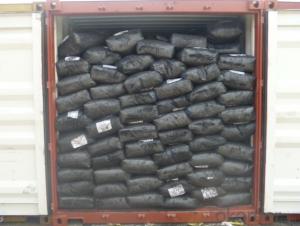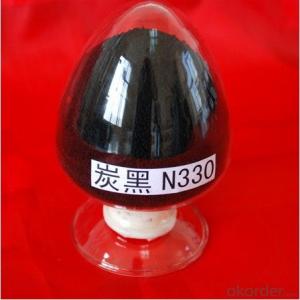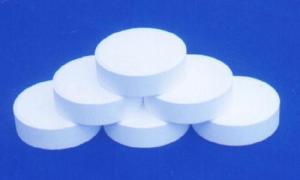Carbon Black N339 Granluar
- Loading Port:
- Tianjin
- Payment Terms:
- TT OR LC
- Min Order Qty:
- -
- Supply Capability:
- 10000MT m.t./month
OKorder Service Pledge
OKorder Financial Service
You Might Also Like
Carbon Black N339 (Granule)
Product Description:
carbon black N339:
1.Usage Rubber Auxiliary Agents;
2.Product Status:Black powder or granular;
3.Standard: ISO 9001:2000
Suggest for Use:
(1) use for passenger tires, the card tire tread rubber, rubber conveyor belt covers, hose, and the various requirements of high abrasion resistance rubber industrial products.
(2) The usage and for the FDA in the tread rubber compound reinforced performance, abrasion resistance and tear properties of population growth near N220 carbon black, squeeze better performance, especially for SBR / BR Rubber and use system. However, the FDA manufacturing tread rubber, its rolling resistance in the N330 series carbon black is the highest, which is in the rubber formula design, must be given.
TDS of the Carbon Black N339
Product Varieties | N339 | Pouring density(kg/m3) | 305~385 |
Iodine absorption Value(g/kg) | 85~95 | 300%modulus(Mpa) | -0.4~1.6 |
DBP absorption Value (10-5m2/kg) | 115~125 | Ash content | ≤0.7% |
24Mn DBP(10-5m2/kg) | 94~104 | 45um sieve residue | ≤0.05% |
CTAB surface area(103m2/kg) | 87~99 | 500um sieve residue | ≤0.001% |
STSA/(103m2/kg) | 83~93 | Impurity | NO |
Nsa surface area(103m2/kg) | 86~96 | Fine content | ≤10% |
Tint strength(%) | 106~116 | Tensile strength(Mpa ) | ≥-0.5 |
Heatloss(%) | ≤2.5 | Elongation at failure | ≥-50% |
Safety:
As a matter of good industrial hygiene, gloves and safety glasses with side shields or better eye protection should be worn when handing Carbon Black ,For more information, refer to the MSDS.



- Q: Before and after the reaction, the chemical properties and quality of the water did not change, and the water was the catalyst
- Dry aluminum powder and iodine does not react, there is water to react.
- Q: Exemplify the use of green catalysts in green chemistry
- How can a green catalyst, they do not react
- Q: The "one-to-two change" of the catalyst is that the quality and chemical properties of the reactants are constant or the quality and chemical properties of the catalyst are constant?
- The quality and chemical properties of the catalyst are unchanged
- Q: What are the chemical reaction conditions in organic chemistry are catalyst and heating, please elaborate
- This really does not have omnipotent law, their own more than one point, you can classify to remember, when I was in high school is in accordance with the notes, such as poly, polycondensation and the like. In general, the double triple bond addition, plus halogen is not the conditions, plus HCl, HBr and the like to heat; dehydration reaction generally concentrated H2SO4 heating, dehydration condensation is also; there are some special, such as ethylene added to ethanol Special temperature requirements, it seems that 120 degrees, there are other; other addition poly, polycondensation some need catalyst. The The In short, the conditions are many, in general, you do not go to the high school to do more questions after the feeling, encounter problems do not panic general experience can come out according to experience, this also depends on the usual accumulation, if the equation conditions Wrong to deduct points, it is not worthwhile. There are some questions when the examination will give you some information, whether you know do not know should see clearly, although some of the reaction but the subject to the conditions are not the same, when you do according to the title to write conditions, this will not wrong. In addition, thank you for your help, I do not seem to know you
- Q: What about the chemical reaction of the catalyst if there is no catalyst?
- The catalyst used to heat and hold, the material will not react between.
- Q: What are the characteristics of the catalyst in the chemical reaction?
- In simple terms: the catalyst itself is involved in the reaction, the quality of the reaction before and after the same, the ingredients do not change. The catalyst can change the rate of chemical reaction, increase the rate of reaction called catalyst, slow the inhibitor.
- Q: Junior high school chemistry - chemical reaction before and after the quality and chemical properties of the material must be the catalyst?
- It is not always possible that the equivalent reaction, i.e. one or more of the reactants, is the same as the relative atomic mass of one or more of the products and the coefficients in the chemical equation are the same
- Q: What is the catalytic efficiency of ordinary chemical catalysts?
- Different reactions, with the same catalyst, the catalytic efficiency is different. The same reaction, with different catalysts, the catalytic efficiency is also different
- Q: Why can some catalysts be reused in (chemistry)?
- Because the catalyst in the chemical reaction before and after the quality and chemical properties have not changed, so in the chemical reaction can be reused.
- Q: Will the catalyst be able to increase the rate of chemical reactions?
- The catalyst has a positive catalyst and a negative catalyst, and generally does not specifically refer to both the positive catalyst, i.e., the catalyst that accelerates the reaction.
Send your message to us
Carbon Black N339 Granluar
- Loading Port:
- Tianjin
- Payment Terms:
- TT OR LC
- Min Order Qty:
- -
- Supply Capability:
- 10000MT m.t./month
OKorder Service Pledge
OKorder Financial Service
Similar products
Hot products
Hot Searches
Related keywords


























